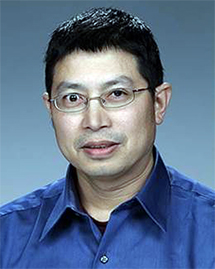Seminars
Prof. Xiaohua Hu
Energy and Transportation Science Division
Oak Ridge National Laboratory
Linking Microstructure and Material Ductility through Microstructure-based Modeling

ABSTRACT: Tensile elongation has been deemed as the most important characteristic representing ductility in a material. In other deformation such as bending and hole expansion, however, a material with large elongation sometimes shows worse ductility such as bendability and critical hole expansion ratio. This leads to the question what the true ductility of a material is. Among all the deformation modes, the tension is the simplest mechanical test, but has much more deformation freedom with the width and thickness direction unconstrained, leading to deformation instability, i.e., the necking diffused along the width direction and localized along the thickness direction. The deformation before necking is usually called the uniform deformation, while it is called post-necking deformation after necking. To understand the influence of microstructures on the material true ductility, a two-stage modeling scheme is developed where a plane stress model is used to study the pre-necking behavior, while an innovative edge constrained plane strain post-necking model is developed to simulate the post-necking deformation and the capability of a material to resist through-thickness thinning. With this post-necking model, the true fracture strain can be assessed. The failure mode and ductility of Aluminum alloys with dilute particles and their distributions have been successfully calculated. It has been shown the true fracture strains are well correlated to other deformation modes such as bending and hole expansion with deformation instability is absent. For the bendability of a sheet metal material, an innovative macro-micro approach has been developed to connect sample-scale simulations to local microstructures. Using this approach, the drastic bendability difference of the AA5754CC and AA5754DC aluminum alloys are successfully captured. As for complex-microstructure multi-phase materials such as advanced high strength steels, the determination of the constitutive laws of different phases is important for determination of the material true ductility. A combined high energy X-ray diffraction and crystal plasticity modeling approach has been established to inverse calculate the constitutive law of the individual phases. Using this approach in two DP-980 steels, it has demonstrated that tempered DP980 alloy has much better critical hole expansion ratio, although it has smaller tensile elongation, but more post-necking elongation than the non-tempered version of DP-980 steel. This is because the tempered alloy has smaller phase property disparity.
BIOGRAPHY: Dr. Xiaohua Hu obtained his Ph.D. degrees at the State Key National Laboratory at the University of Science and Technology Beijing in 1998. Starting from 1999, he was a postdoctoral researcher at the Netherlands Institute for Metals Research (NIMR) located at Delft University of Technology, where he developed a model to calculate interfacial adhesion energy of Zn coated steels. In 2001, he began to work as senior design engineer at Bovis Lendlease Microelectronics in Veldhoven, the Netherlands. He then moved to Belgium to work as a junior researcher in the Department of Materials and Metallurgical Engineering of The Katholieke Universiteit Leuven in Belgium from 2003 and worked on micromechanical modeling of work hardening behavior of pearlitic steels. He briefly worked as research associate at Case Western University in 2005 in thermal fatigue behavior of aluminum die casting and then moved to Canada to work as research associate at McMaster University, where he worked on the study the formability of automotive sheet aluminum alloys. From 2010, he was a CAE analyst at Litens Automotive Group and worked on finite element stress and fatigue analysis of automotive timing belt and accessory drive components such as tensioners, etc. He was then hired as research scientist at Pacific Northwest National Laboratory (PNNL) in 2012, where he developed the integrated modeling approach from sheet trimming to stretching and hole piercing to hole expansion of automotive aluminum sheet alloy and advanced high strength steels. He served as principal investigator of a couple of DOE-VTO projects on advanced high strength steels and Mg sheet alloy development. He started to work at Oak Ridge National Laboratory from 2018 and served as PI for three high performance computing projects, collaborating with Pratt & Whitney, Ford Motor Company and Arcelor Mital Corp. He participated in several DOE-VTO core programs such as joining, power train material and light metals programs. Due to his contributions to the development of advanced high strength steels, he received the 2018 Institute Medal and 2019 Institute Medal Finalist awards from the American Iron and Steel Institute.